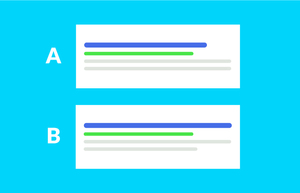Google Ads is an excellent platform for lots of businesses to drive more sales and grow. But unfortunately, most advertisers don’t know how to use it to get results at lower costs.
If you find yourself spending a lot of money on Google Ads and getting little to no results, this is for you.
In this guide, you’ll learn seven easy ways to save money on Google Ads by driving higher conversions at a lower CPC.
Let’s get started!
1- Improve Your Ad Copy
Your ad copy is the first thing your target audience interacts with before working with you. It’s where all the selling happens. Creating a great offer and targeting the right audience are essential.
But…
None of that matters if you don’t have a persuasive copy to convert leads into customers.
You should always give users a reason to click on your ad. And keep your paragraphs short and on-point while including relevant keywords.
Also, be sure to use a clear call-to-action to boost click-through rates.
2- Increase Your Quality Score
Quality Score is a 1-10 rating that Google gives to each keyword in your ad groups. It reflects ad performance and how good a keyword is, based on the following three factors:
- Expected CTR
- Ad Relevance
- Landing Page Experience
A higher Quality Score means lower CPC and better-positioned ads for your campaign, both of which are factors that help drive higher-quality leads to your offer.
To increase your Quality Score:
Make sure your keywords are super-specific to your different ad groups. And always delete any unwanted terms or keywords from your campaigns.
You must also match the content on your different landing pages to each ad group in your campaign.
More importantly:
Try to improve the user experience on each landing page by improving page speed, creating a clear hierarchy, and writing strong CTAs that convert.
3- Use Location Targeting
Do you own a small business where you only serve customers locally? Or perhaps you sell products that you only ship to specific locations?
If you’re targeting a global audience for such offers, it’s clear why your conversion rates are so low. And no matter how great your ad is or how big your budget is, you’ll always be losing money.
Before starting any ad campaign, you need to be smart about your geographic targeting preferences.
Identify where your target audience is located. Then, update your targeting preferences to those specific areas.
4- Add Negative Keywords
Negative keywords are the words and phrases you don’t want your ads to be displayed for. They exist to help you save money by not showing your offers to irrelevant audiences.
For example:
If you’re selling brand new laptops, you don’t want your ads to appear to someone searching for “used laptops.”
So, you need to include “used” in your list of negative keywords.
To give you some examples, here are some words you can add to your list:
- Free
- Cheap
- Discount
- Youtube
- Quora
- Class
- Book
- Courses
- Review
- Picture
- Price
Your list of negative keywords depends on your industry, company, products, and target audience.
So, you can only build one of your own by gaining more knowledge and experience from running ads.
5- Bid Smartly
What most advertisers do when trying to save money is keep their CPC on the lower end of the bidding range. But that gives them horrible ad placements, lower impressions, and even lower conversions.
Others might approach this by bidding much higher to dominate the results pages and target a better audience. However, they might be bidding against themselves and leaving a lot of money on the table.
The best way to go about this is to test, learn, and iterate.
Try out different CPC bids for various keywords, then identify which ones are bringing the best ROI.
Also:
Go for high-intent keywords first instead of high volume. That works even if it means adding keywords to your list with only a few dozen searches per month.
6- Leverage A/B Testing
Marketing isn’t an exact science for anyone of us to be able to tell what’s going to work for sure.
So, it’s always a good approach to test out different ads before settling on a final one for any of your offers.
Make small changes to your ads and let them run for a while to see which ones perform best. You should also optimize your landing pages and test out different layouts and language.
As you start to gather more data, you’ll learn a lot about your target audience and which language resonates the most with them.
7- Create an Ad Schedule
Once you’ve been running ads for a few months, you’ll have some data to focus on what’s already working.
Google will generate detailed reports for you to know during which days or hours your audience is converting best.
Now:
You can adjust your ad to only be visible during peak times and easily save money on Google Ads.
Wrapping it up
Looking to take your business to the next level with online / paid ads and marketing? We have a team of professionals ready to help you!
Check out our digital marketing services and get a quote for your project today.



